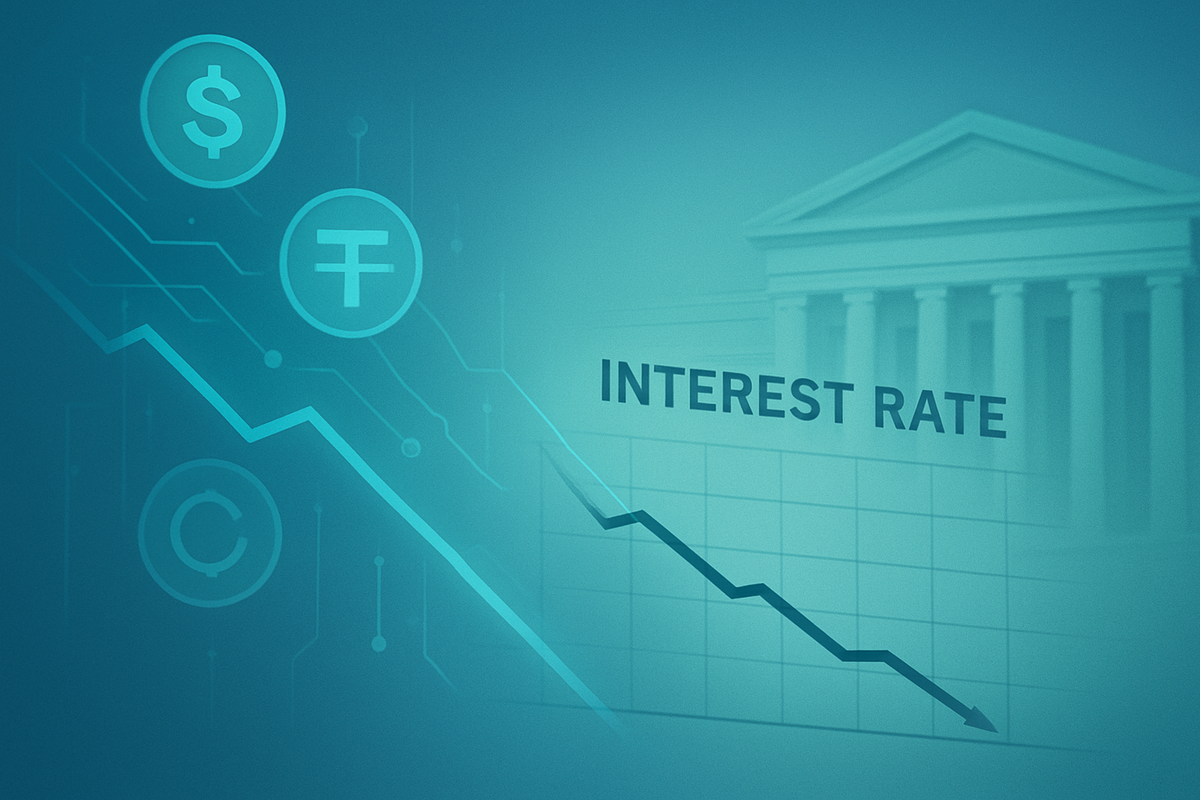
Federal Reserve Governor Stephen Miran delivered a significant speech today, November 7, 2025, at the BCVC Summit 2025, outlining a compelling argument that the burgeoning growth of stablecoins could exert substantial downward pressure on the neutral interest rate (r*). This theoretical rate, which neither stimulates nor restricts economic growth, is a critical benchmark for monetary policy. Miran's remarks suggest a future where the widespread adoption of digital assets fundamentally alters the landscape of traditional finance, potentially necessitating a re-evaluation of the Federal Reserve's approach to interest rate setting.
His statement carries immediate implications for the direction of monetary policy, particularly given his existing advocacy for more aggressive interest rate cuts. Miran posits that if stablecoin proliferation indeed lowers r*, then the Federal Reserve's policy rates would also need to be commensurately lower to avoid an unintentionally contractionary stance. This perspective not only adds a new dimension to the ongoing debate about the future of digital currencies but also raises crucial questions about the long-term effectiveness of conventional monetary tools in an increasingly digitized financial ecosystem.
Governor Miran's Deep Dive into Stablecoin Mechanics and Monetary Policy
During his address titled "A Global Stablecoin Glut: Implications for Monetary Policy" at the Harvard Club of New York City, Governor Miran meticulously detailed the mechanism through which stablecoins could influence the neutral interest rate. He emphasized that the significant growth in stablecoin usage would likely lead to a reduction in r*, even with "relatively conservative estimates." The core of his argument lies in the asset backing of these digital currencies. Stablecoins, which are designed to maintain a stable value, typically pegged to the U.S. dollar, are predominantly backed by highly liquid, safe assets such as cash or short-dated U.S. Treasuries.
As the demand for stablecoins escalates and their market capitalization expands, issuers are compelled to acquire and hold a larger volume of these underlying assets to ensure the stability and redeemability of their tokens. This increased demand for U.S. Treasuries and other highly liquid dollar assets naturally drives up their prices. Consequently, the yields on these assets are pushed lower. Miran explained that this continuous influx of funds into safe assets effectively increases the net supply of loanable funds within the broader economy, thereby exerting a downward force on the neutral interest rate. Some research cited by Miran suggests that if stablecoins achieve widespread adoption and are fully backed by U.S. securities, they could potentially reduce interest rates by as much as 40 basis points.
The timeline leading up to these comments reflects a growing awareness within central banking circles regarding the potential systemic impact of digital assets. While discussions around central bank digital currencies (CBDCs) have gained traction, Miran's focus on privately issued stablecoins highlights a distinct, market-driven influence on monetary conditions. Key players involved in this discussion include the Federal Reserve itself, stablecoin issuers like Tether (USDT) and Circle (USDC), traditional financial institutions, and the broader cryptocurrency ecosystem. Initial market reactions to such statements often involve increased scrutiny of stablecoin reserve compositions and a heightened debate among economists and policymakers about the appropriate regulatory framework for these digital assets. Miran's comments align with his consistent advocacy for lower interest rates, viewing the current monetary policy as overly restrictive, and his analysis of stablecoins provides a fresh rationale for his position.
Companies Navigating the Stablecoin-Driven Interest Rate Shift
The scenario painted by Governor Miran, where stablecoin proliferation drives down neutral interest rates, presents a complex landscape of opportunities and challenges for various public companies and financial institutions. The core mechanism—stablecoin issuers' increased demand for safe, liquid assets like U.S. Treasuries—will inevitably reshape profitability and competitive dynamics across the financial sector.
Stablecoin issuers themselves, such as Circle (issuing USDC) and Tether (issuing USDT), stand as primary beneficiaries of increased adoption and market capitalization. As their stablecoins become more widely used for payments, remittances, and digital asset trading, the demand for their tokens grows, leading to an expansion of their reserve holdings. Historically, these issuers have generated substantial revenue from the interest earned on these reserves. However, a sustained downward pressure on neutral interest rates would commensurately reduce the yields on these reserve assets, thereby compressing the lucrative profit margins these companies have enjoyed. This shift could signal an end to the "easy profit margin" era, compelling issuers to innovate and diversify their revenue streams beyond simply holding reserves. Regulatory clarity, such as that provided by the recently enacted Guiding and Establishing National Innovation for U.S. Stablecoins Act (GENIUS Act), could further legitimize the sector, opening doors for broader institutional integration and new service offerings.
Conversely, traditional commercial banks are poised to be significant losers in this environment. A lower neutral interest rate, exacerbated by stablecoin growth, directly impacts their net interest margins (NIMs). As the interest banks earn on assets like loans decreases, and the interest they pay on many liabilities (especially non-interest-bearing deposits) cannot easily fall below zero, their profit spreads narrow significantly. Furthermore, stablecoins offer an attractive alternative for holding funds, potentially leading to substantial deposit outflows from traditional banks. This "deposit flight" diminishes banks' primary source of low-cost funding for lending, forcing them to seek more expensive alternatives and further eroding profitability. Companies like JPMorgan Chase (NYSE: JPM) and Bank of America (NYSE: BAC) would need to strategically adapt, potentially by developing their own stablecoin offerings or integrating with decentralized finance (DeFi) protocols to retain market share.
Cryptocurrency exchanges, including Coinbase Global (NASDAQ: COIN) and platforms like Robinhood Markets (NASDAQ: HOOD), are positioned as potential winners. Stablecoins are integral to the crypto ecosystem, serving as crucial liquidity providers and a primary medium of exchange. Increased stablecoin usage directly translates to higher trading volumes for other cryptocurrencies, generating more transaction fees for exchanges. These platforms are also expanding into comprehensive financial service providers, offering stablecoin-related products like on-chain lending and compliant transaction infrastructure. Similarly, fintech companies that have proactively embraced stablecoins, such as PayPal (NASDAQ: PYPL) with its PYUSD stablecoin, and Block (NYSE: SQ), are likely to benefit by leveraging their existing user bases and merchant networks for stablecoin-based payments and services. Traditional foreign exchange (FX) providers, like Corpay (NYSE: CPAY), might face challenges as stablecoins streamline international money transfers, bypassing their traditional conversion processes and threatening their fee-based income.
Broader Implications: Stablecoins and the Evolving Financial Landscape
Governor Miran's analysis of stablecoins' potential to depress the neutral interest rate fits squarely within several overarching trends reshaping the global financial system. Foremost among these is the accelerating digitization of finance, where digital assets are moving from niche investments to potentially foundational elements of payment and settlement systems. His comments underscore the growing recognition that privately issued digital currencies, distinct from central bank digital currencies (CBDCs), can have significant macroeconomic effects, challenging the traditional monopolies of central banks and commercial banks in money creation and intermediation.
The ripple effects of stablecoin growth and its impact on interest rates are multifaceted. For central banks globally, Miran's warning highlights a potential erosion of monetary policy efficacy. If the neutral rate is indeed lower, then traditional policy tools, particularly the setting of the federal funds rate, might require recalibration to avoid unintended contractionary effects or, conversely, to prevent overheating if the true neutral rate is misjudged. This also increases the risk of central banks hitting the zero lower bound more frequently, limiting their room for maneuver during economic downturns. For traditional financial partners and competitors, particularly commercial banks, the threat of disintermediation is profound. Stablecoins offer an alternative to bank deposits, and as payment rails, they can bypass traditional correspondent banking networks, impacting fee revenues and funding sources.
Regulatory and policy implications are perhaps the most significant. Miran's speech adds urgency to the ongoing debate about comprehensive stablecoin regulation. The passage of legislation like the GENIUS Act is a step towards establishing frameworks, but the macroeconomic implications raised by Miran suggest that oversight must extend beyond consumer protection and financial stability to consider broader monetary policy effects. Policymakers will need to grapple with how to supervise reserve assets, ensure interoperability, and mitigate systemic risks posed by large, globally adopted stablecoins. Furthermore, the discussion around stablecoins will inevitably intersect with the development of CBDCs. Miran's argument could be interpreted as a subtle push for central banks to accelerate their CBDC efforts to maintain control over the monetary system, or it could simply highlight the need for careful coexistence.
Historically, comparisons can be drawn to the rise of money market funds in the 1970s and 80s. These funds offered higher yields than traditional bank accounts, leading to significant deposit outflows from banks and forcing them to innovate and compete for deposits. While the scale and technological underpinnings are different, the principle of a new financial instrument attracting funds away from traditional intermediaries and influencing broader interest rate dynamics bears a striking resemblance. Similarly, the growth of offshore dollar markets has long influenced global liquidity and interest rates, demonstrating how alternative pools of dollar-denominated assets can impact the domestic financial system. Miran's analysis positions stablecoins as a contemporary iteration of these historical forces, albeit with a digital twist that amplifies their potential speed and reach.
What Comes Next: Navigating a Stablecoin-Influenced Future
Following Governor Miran's insightful remarks, coupled with recent discussions from other Federal Reserve officials like Governor Christopher Waller, the short-term future will likely be characterized by intensified regulatory focus and strategic positioning within the digital asset space. We can expect an acceleration of efforts to establish a clear U.S. regulatory framework for stablecoins, building on existing initiatives like the Guiding and Establishing National Innovation for U.S. Stablecoins Act (GENIUS Act) and the CLARITY Act. This will involve defining legal backing requirements, ensuring reserve transparency, and clarifying jurisdictional oversight. Stablecoins that operate within these emerging, robust regulatory frameworks, especially those backed by major financial institutions, are poised to gain a significant competitive advantage and increased adoption as safer, more compliant alternatives.
In the long term, the implications are more profound, pointing towards a potential revolution in global payments and a re-evaluation of monetary policy tools. Stablecoins hold the promise of offering faster, cheaper, and 24/7 transactions for both retail and cross-border use cases, which could significantly bolster the international role of the U.S. dollar. However, this widespread adoption also presents challenges for monetary policy. If, as Miran suggests, stablecoin growth pushes down the neutral interest rate, central banks may need to adapt their policy frameworks and targets to maintain economic stability, potentially facing the zero lower bound more frequently. Financial institutions will need to undertake significant strategic pivots, including investing heavily in blockchain infrastructure, expanding service offerings to include crypto custody and tokenized products, and proactively engaging with policymakers to shape favorable regulatory environments. Enhanced risk management and cybersecurity will also be paramount.
Market opportunities will emerge in efficient payments, new financial product development (e.g., tokenized real-world assets), and reinforcing the global reach of the dollar, particularly in emerging markets seeking stable alternatives to volatile local currencies. However, challenges persist, including ongoing regulatory uncertainty, financial stability risks associated with "run risk" on stablecoins, and potential complications for monetary policy transmission if significant economic activity shifts outside traditional banking. Competition from central bank digital currencies (CBDCs) in other nations also remains a factor, though a U.S. CBDC faces political resistance. The most likely scenario involves a regulated mainstream integration of stablecoins, where a robust U.S. framework allows for their issuance by both banks and non-banks under stringent oversight. This would see stablecoins become an accepted, efficient component of the payment system, with financial institutions adapting their services and central banks developing advanced supervisory tools, making the neutral interest rate a more central point of monetary policy discussion.
Comprehensive Wrap-up: Stablecoins Reshaping Monetary Policy and Markets
The comments by Federal Reserve Governor Stephen Miran represent a pivotal moment in the ongoing dialogue between traditional finance and the rapidly evolving world of digital assets. His assertion that stablecoin growth could exert downward pressure on the neutral interest rate (r*) is not merely an academic observation but a direct challenge to established monetary policy paradigms. The core takeaway is that the increasing demand for safe, liquid assets like U.S. Treasuries to back stablecoins creates a fundamental shift in the supply of loanable funds, with tangible consequences for interest rates and, by extension, economic growth.
Moving forward, the market will need to grapple with the implications of a potentially lower neutral rate, which could necessitate a recalibration of the Federal Reserve's policy stance to avoid inadvertently stifling economic activity. This shift will likely accelerate the development of comprehensive regulatory frameworks for stablecoins, as policymakers seek to harness their benefits while mitigating systemic risks. Investors should watch closely for further legislative progress, such as the full implementation of the GENIUS Act, and observe how stablecoin issuers adapt their business models in an environment of potentially compressed reserve yields.
The lasting impact of Miran's perspective could be profound, cementing stablecoins as a significant factor in macroeconomic considerations. It underscores the need for financial institutions—from traditional banks like JPMorgan Chase (NYSE: JPM) to fintech innovators like PayPal (NASDAQ: PYPL) and crypto exchanges like Coinbase Global (NASDAQ: COIN)—to strategically adapt, innovate, and integrate digital asset capabilities into their core offerings. The future financial landscape will undoubtedly be a hybrid one, where traditional and digital currencies coexist, and the effectiveness of monetary policy will increasingly depend on understanding and managing the interplay between them. The coming months will reveal the extent to which Miran's warning shapes policy decisions and investment strategies, as the financial world adjusts to the undeniable influence of stablecoins.
This content is intended for informational purposes only and is not financial advice





